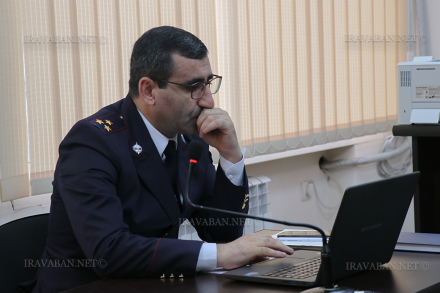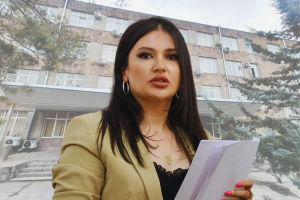The trial of Judge Arusyak Aleksanyan, her assistant Tamara Petrosyan, and lawyer Erik Aleksanyan continued on December 3 at the Anti-Corruption Criminal Court. The session is presided over by Judge Vahe Dolmazyan.
On October 17, 2022, the Supreme Judicial Council approved the General Prosecutor’s Office’s motions to initiate criminal prosecution and consent to deprivation of liberty against Judge Arusyak Aleksanyan. Within the same case, lawyer Erik Aleksanyan was also charged under Article 46-441 of the Criminal Code, that is, assisting an official in abusing power or official authority or influence conditioned by them or exceeding authority. Tamara Petrosyan, Arusyak Aleksanyan’s assistant, was also charged in this case.
According to the charges, the judge made an obviously unjust judicial act and abused official powers. She satisfied the motion of Erik Aleksanyan, the defense attorney of Sergey Grigoryan, known by the nickname “Faz” and considered a criminal authority, changed the latter’s preventive measure and released him from detention for a bail of 2.5 million drams. Sergey Grigoryan is a friend of Arusyak Aleksanyan’s brother, Rustam Aleksanyan.
According to Iravaban.net, at this session, Andranik Manukyan, one of defendant Arusyak Aleksanyan’s defenders, presented a motion.
The motion concerned the results of internal surveillance OSA conducted against Judge Arusyak Aleksanyan in 2022. Specifically, the defender motioned to declare inadmissible the results of the implemented measures – the audio-video recordings and 2 laser discs – as evidence in this case.

He stated that back in 2022, a motion was submitted to obtain permission to conduct internal surveillance OSA against Arusyak Aleksanyan for a period of 2 months, which was satisfied by court decision.
In September of the same year, another motion was submitted to extend the duration of these OSAs, which was also satisfied by the September 1 decision. The purpose of implementing these measures was to identify the person who allegedly committed the crime at the time of or immediately after its commission, as well as to detect and prevent their criminal activity.
According to him, the court justified the decisions to grant internal surveillance permission and extend the OSA terms by the fact that they stem from the necessity of revealing the alleged serious crime.
On December 24, 2022, by decision of Senior Investigator Ayvazyan of the NSS Investigation Department conducting pre-trial proceedings, the audio-video recordings and 2 laser discs obtained as a result of internal surveillance OSA implemented against Arusyak Aleksanyan were recognized as extra-procedural documents in the criminal proceedings.
The defender raises the following question in his motion:
Are the 2 laser discs containing video-audio recordings fixed as a result of internal surveillance OSA implemented against Aleksanyan, recognized as extra-procedural documents, admissible evidence in this criminal case?
Referring to Part 3 of Article 96 of the Criminal Procedure Code, he noted that video-audio recordings, videos, audio recordings and other documents obtained with court permission as a result of OSA activities carried out within the framework of criminal proceedings can be recognized as extra-procedural documents and attached to the proceedings when the corresponding measure is implemented to prevent, suppress the alleged crime or to identify the person who allegedly committed the crime at the time of or immediately after its commission.
 According to him, at the time of filing the motions and making court decisions, the person who was attributed to receiving the bribe was known, and during that time the motion was submitted on the grounds that there were sufficient data in the available information about the judge receiving a bribe, which contradicts the purposes of the OSAs implemented against Aleksanyan.
According to him, at the time of filing the motions and making court decisions, the person who was attributed to receiving the bribe was known, and during that time the motion was submitted on the grounds that there were sufficient data in the available information about the judge receiving a bribe, which contradicts the purposes of the OSAs implemented against Aleksanyan.
The OSA implementing body (NSS) recorded that Judge Aleksanyan regularly demanded and received large bribes of 2 to 5 million drams from various persons in various court cases.
“In the aforementioned decisions, the court recorded that there is a need to reveal the alleged serious crime, as well as to prevent the probable continuation of criminal activity. It is obvious that both the OSA implementing body and the court considered that at least one case of receiving a bribe by Judge Arusyak Aleksanyan had already taken place in objective reality, which in turn excludes that internal surveillance OSA was implemented against Arusyak Aleksanyan for the purpose of preventing or suppressing the alleged crime of receiving a bribe by the judge,” said Manukyan.
Presiding Judge Vahe Dolmazyan inquired whether the specified provisions of Article 96 should be given a narrow interpretation, or whether this circumstance should be considered in its entirety, since it is one thing to evaluate the interpretation of the given norm in the context of circumstances present in the case, and another thing to discuss the specific criminal procedure situation.
Andranik Manukyan said that to this day there is no data about even having a premise to think about who the bribe-giving person was at that time: “We have mentioned this issue in previously submitted motions, the NSS brought motions regarding alleged bribe receiving exclusively in order to make it possible to align the motion with the requirements of the ‘Law on Operative-Investigative Activities’ – creating an apparent impression that we are dealing with a serious crime.”
Prosecutor Armen Gevorgyan objected to the motion, stating that there are no grounds to agree with the justifications contained in it: “It is disguised, directly related to the motions previously submitted by the defense, in which the latter disputed the question of correspondence or non-correspondence to reality of information regarding alleged bribe receiving when implementing operative-investigative measures.”
Gevorgyan now also insisted on his previously stated position that there are no factual circumstances related to the implementation of these measures in the case, the data available in the case were sufficient to obtain permission to implement OSA.
He reminded the party and the court that these actions have also been evaluated in this court and the legitimacy of the first instance court decisions granting permission to implement OSA has been subjected to judicial review.

“The implementation of OSA, as such, aims to verify the received operative information, and this does not mean that the operative-investigative body is obliged to submit a report as soon as operative information is received, and the investigator, in turn, is obliged to transition to the field of secret investigative actions. As a result of OSA, this information should be somewhat confirmed or refuted, it is for this purpose that permission restricting the right to privacy of personal life is sought from the court,” said the prosecutor.
Gevorgyan cited the reasoning part of two court decisions, emphasizing that no contradiction can be brought, they have been fully interpreted in the context of Article 96 of the law.
The presiding judge also directed other questions regarding the motion; its discussion was concluded.
According to Iravaban.net, the court decided to postpone the resolution of the motion, the presiding judge noted that within the framework of this discussion, reference was made to a number of documents that still need to be appropriately evaluated by the court. The court’s decision will be published in the final judicial act.
Details in the video.
Mariam Shahnazaryan


















